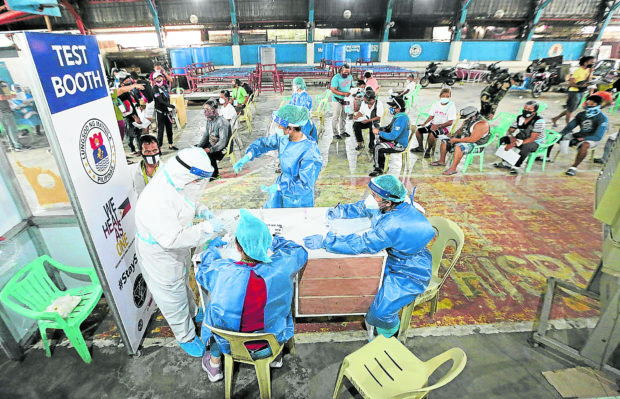WHO lauds ‘proactive’ PH but notes delays in contact tracing, isolation

‘DONE A LOT’ Health workers prepare to test residents of Baseco Compound in Tondo, Manila, for coronavirus infection on Tuesday. The World Health Organization says the Philippines has “done a lot” to control the spread of the virus, but there are areas of the government’s response that need to be improved. —GRIG C.MONTEGRANDE
MANILA, Philippines — While it lauded the Philippines for its efforts to suppress the spread of the new coronavirus, the World Health Organization (WHO) said on Tuesday there were still areas of the response that needed to be improved for the country to effectively contain the outbreak.
WHO country representative Rabindra Abeyasinghe recognized that the government had already “done a lot” to control the spread of the virus since the first local case was detected in March. These include putting in place measures for early diagnosis, contact tracing, and isolating and quarantining of close contacts.
Room for improvement
“The Philippine government is very proactive in the enforcement of the nonpharmaceutical interventions and in ensuring that there are mobility restrictions,” Abeyasinghe said in a briefing.
“[B]ut there’s still room for improvement on the harmonized speedy contract tracing and management of close contacts and early isolation of positives. Delays in doing this have resulted in more secondary cases happening and more secondary transmission occurring,” he added.
The WHO official, however, pointed out that the government was already dealing with this by putting in place measures to strengthen these areas, that’s why the country is now seeing a gradual decline in new cases.
Article continues after this advertisementEarlier, Health Undersecretary Maria Rosario Vergeire said that while the country’s COVID-19 response had improved, she noted certain areas that needed to be refined, such as contact tracing, where there is a need to better identify the close contacts of a patient.
Article continues after this advertisement“For us, we want local governments to trace as much of the first-level contacts,” she said.
A close contact is someone who had face-to-face interaction with a probable or confirmed case within a meter and for more than 15 minutes as well as those who cared for a probable or confirmed case without wearing the appropriate protective gear.
Tracing the contacts of positive cases is the responsibility of the Department of the Interior and Local Government (DILG). To effectively trace these close contacts, the DILG hired an initial 10,136 tracers out of the 50,000 allotted to it under the Bayanihan to Recover as One Act.
Interior Undersecretary Jonathan Malaya said on Monday the new recruits would be deployed to their localities this week.
Half of WesPac cases
On Tuesday, the Department of Health (DOH) recorded 2,093 additional infections, pushing the overall number of confirmed cases to 326,833. The Philippines’ total number of cases accounts for half of the recorded cases in the 23-member WHO Western Pacific region, which includes China where the SARS-CoV-2 virus originated.
Metro Manila accounted for a little over a quarter of the new cases, 557, followed by Cavite (253), Iloilo (166), Bulacan (124) and Batangas (118). The majority of the newly infected, or 1,741, got sick between Sept. 23 and Oct. 6, while 221 fell ill between Sept. 1 and 22.
The slightly lower number of new cases, however, may have been due to the failure of 20 laboratories to submit their data to the DOH on time.
The DOH reported that 209 more patients had recovered, raising the number of COVID-19 survivors to 273,313. But the death toll climbed to 5,865 with the deaths of 25 more patients.
Of the newly reported deaths, nine died this month, 15 in September and one in August. Nine of the fatalities were from Metro Manila, six from Calabarzon, three from Caraga, and one each from Central Luzon, Bicol, Central Visayas, Zamboanga, Northern Mindanao and the Bangsamoro Autonomous Region in Muslim Mindanao.
The residence of one of the fatalities has yet to be verified.
The recoveries and deaths left the country with 47,655 active cases, of which 85.6 percent were mild, 9.5 percent asymptomatic, 1.6 percent severe and 3.4 percent critical.
A total of 3,711,021 people have been tested for the coronavirus by the 141 accredited laboratories. The Philippine Red Cross said in a statement that its 21 laboratories accounted for at least a million of the tests conducted.